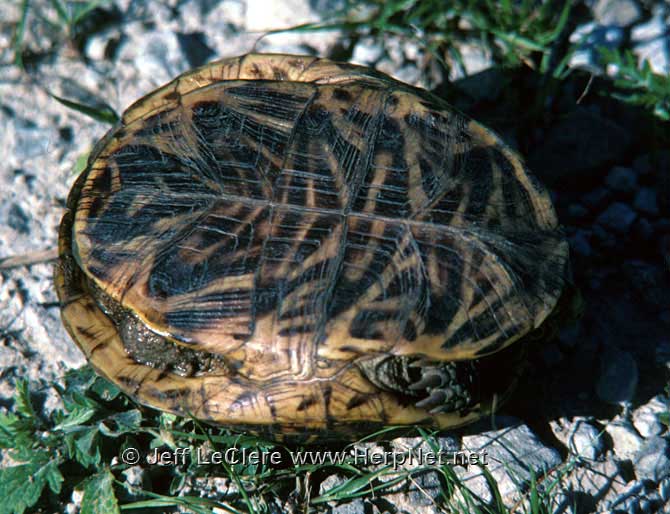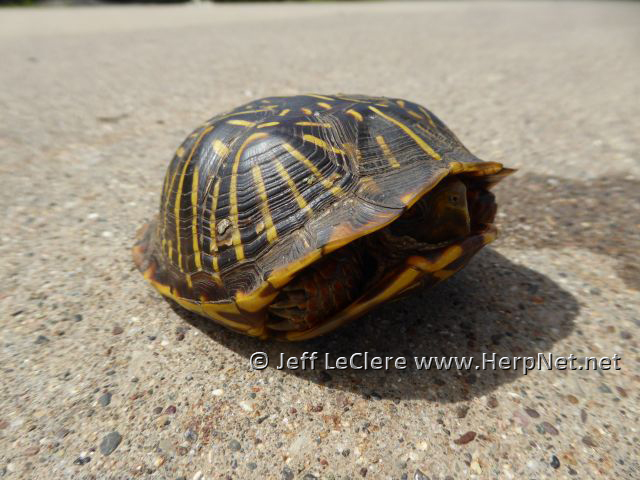Ornate Box Turtle (Terrapene ornata)
by Jeff LeClere
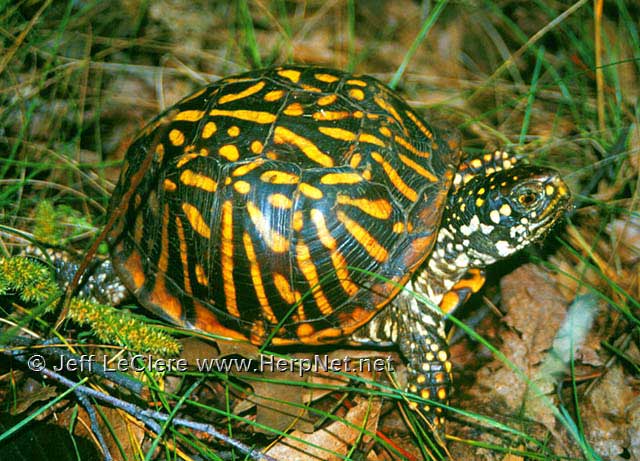
Status
THREATENED and Species of Greatest Conservation Need. It is illegal to kill or collect this species by law in Iowa. We are looking for box turtle reports in southern or western Iowa, especially.
Description
The ornate box turtle is a truly unique Iowa turtle. It is the only turtle in Iowa that is fully terrestrial. Specimens grow to about 5 inches carapace length. The carapace is high domed and quite tortoise-looking. It is uniquely marked with yellow radiating lines on a black or brown ground color. There is also a yellow vertebral stripe down the back. The fully developed plastron has a single front hinge that allows this turtle to completely close its shell. The plastron is yellow with many well defined dark wavy stripes. The skin color is dark, from black to olive, and there are numerous yellow, orange, or red spots on the front legs and head. The feet are not webbed and have a rather club-like appearance. Males have red or orange eyes and a longer tail with the cloacal opening past the marginals. Females usually have brown eyes and much smaller tails. Hatchling box turtles are similar to adults, but may have more yellow coloration on the shell.
Subspecies
The subspecies found in Iowa is the plains box turtle, Terrapene ornata ornata.
Range
The box turtle is only found in few, small scattered populations along the Mississippi Alluvial plain in eastern Iowa, and in isolated pockets with suitable habitat in western, northwestern, and parts of eastern and southern Iowa.
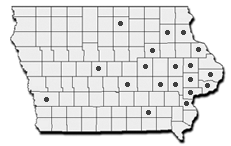

Habitat
Box turtles require sandy open areas. These habitats are disappearing rapidly in Iowa. Many areas that once had good box turtle populations are now gone due to habitat destruction.
Habits
Box turtles are active from April to October. They are diurnal and spend their mornings and evenings traveling and searching for food. The rest of the day and at night, box turtles bury themselves face first into the loose sand. Sometimes they will leave a large part of the back of their shell exposed and other times they will burrow completely. I have even observed a specimen using a burrow under a sheet of tin in Lee County, Iowa. Although box turtles are terrestrial, they are good swimmers and will enter water. They usually are not able to submerge themselves in deep water due to stored fat in the carapace.
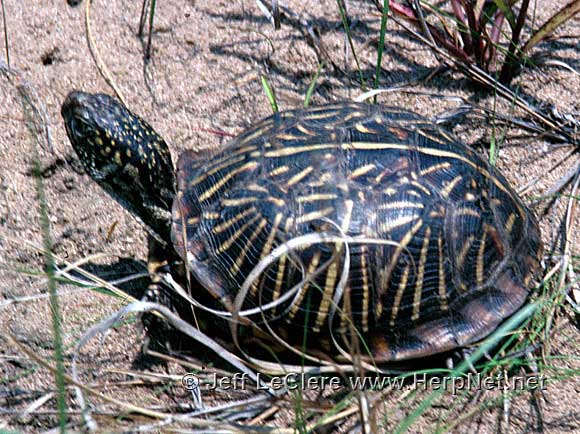
Courtship and mating occurs in spring, but as with many other species, there is some evidence that occasional matings take place in late summer or fall. The female digs a nest in loose sandy soil and deposits five or six eggs. The eggs hatch in two or three months. The hatchlings have many predators and spend most of their time hiding.
Box turtles are thought to be a long-lived animal. Some reports of 50 year old specimens may be true, but are rare. Wild box turtle have an average lifespan of about 25 years (Metcalf and Metcalf, 1985). Adult box turtles are preyed upon by large carnivorous mammals, but humans have the worst effect upon populations. Humans may collect them, but destroying their habitat and automobile mortality is extremely high.
Food
Ornate box turtles are more carnivorous than the eastern box turtle, Terrapene carolina, a southeastern U.S. species of box turtle. Ornates consume mostly insects and earthworms, but a wide variety of other foods will be eaten if they are happened upon. A great amount of carrion is eaten if available, and nearly any dead animal will do! When in season, several kinds of berries are consumed, as well as dandelions, prickly pear cacti, and sometimes colorful fruits and flowers. Most of their water comes from the plant material they eat, but they will drink water when it is available to them.
